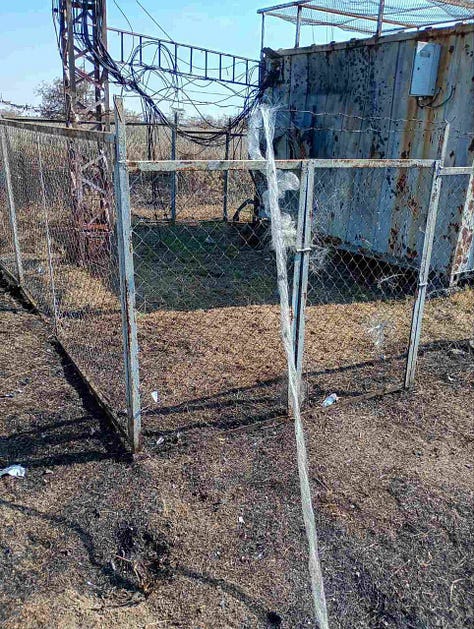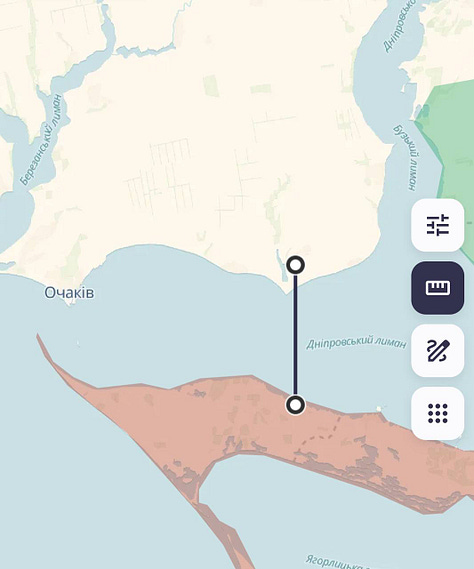Apparent Russian Use Of Fiber-Optic "FPV" Multirotor Drones Over The Dnieper River Highlights Versatility Of Configuration To Overcome Water Obstacles
🇷🇺 🇺🇦
A recent post on the Telegram account of the well-known Ukrainian technical expert and commentator Serhii Beskrestnov—better known by Serhii “Flash”—has drawn attention to Russia’s employment of armed “First Person Video” (“FPV”) multirotor drones of the fiber optic (FO)—as opposed to the radio frequency (RF)—uplink/downlink variety to attack terrestrial targets over the non-trivial obstacle that is the Dnieper River. According to Beshkrestnov, Russian forces attacked a target on the right/western bank of the Dnieper River using an armed FO multirotor drone that was launched from the Russian-occupied Kinburn Spit on the river’s left/eastern bank.



There is no reason to think that Beskrestnov’s account is inaccurate and it bears emphasis there are also indicators—which will be covered later in this post—of the likely employment of armed “FPV” multirotor drone of the FO uplink/downlink variety by Russian forces against to attack targets located across the Dnieper River in the Kherson metrpolitan area. Appreciating the significance of such attacks requires an understanding of how armed “FPV” multirotor drones of the FO uplink/downlink variety function.
Uncrewed aircraft and munitions that use a FO uplink/downlink are equipped with a spool of unsheathed/uncoated fiber optic cable. These are much thinner (resulting in a spool of smaller volume), lighter (resulting in a spool of lower weight), and less resilient than sheathed/coated fiber optic cables used in many other applications. These unsheathed/uncoated fiber optic cables are more like fishing wire than the sheathed/coated ethernet cables—which typically use copper wire as the communication and are not, as such, fiber optic cables—that most readers are likely to be familiar with.
It is important to understand that FO uplink/downlink uncrewed aircraft and munitions transport the FO cable spool in flight. As a result, the FO cable is laid onto the ground—courtesy of gravity—as the uncrewed aircraft or munition moves in flight. No tension is applied to the FO cable as would be the case if the FO cable spool remained stationary at the launch site. This general approach of carrying a spool of some material that serves as a communication medium can be traced back to the Second World War, if not the first use of the Telegraph. Primarily associated with anti-tank missiles in the military context, most anti-tank guided missiles in existence are controlled in flight through a trailing copper wire, with the copper wire spool being carried inside the missile’s fuselage.
Anyone trying to employing armed “FPV” multirotor drones of the FO uplink/downlink variety and other FO uncrewed vehicles and munitions more generally runs into a basic problem when attempting to navigate over a water obstacle: gravity will bring the laid FO cable on to the water’s surface, the laid FO cable will float on the water’s surface, and most of the water on the Earth’s surface is characterized by constant movement. Much like one cannot expect a leaf or an empty (closed) plastic water bottle to remain stationary in many bodies of water, particularly bodies of water that are characterized by a constant flow such as a river, one cannot expect laid FO cable—which will float on the water’s surface—to not move while the armed “FPV” multirotor drone of the FPV continues in flight. The speed at which the floating laid FO cable will move is, of course, determined by the current, wind speed, tidal movements, and related considerations.
In some bodies of water and in shorter range-duration mission profiles, the laid FO cable will not be floating for very long, and the movement of the laid FO cable will not be much of a practical concern. The armed “FPV” multirotor drones of the FO uplink/downlink variety—which are small and light electrically-powered aircraft reliant on onboard electric batteries—that are currently being used in the Russia-Ukraine War are quite slow and tend to have a cruise speed of less than 100 kilometers per hour. A cruise speed of 60 kilometers per hour equates to a cruise speed of 16.66 meters per second. Crossing the 12 or so kilometers distance that the Russian armed “FPV” multirotor drone of the FO uplink/downlink variety may have crossed from the Kinburn Spit to the Ukrainian-controlled right/western bank of the Dnieper River likely took some 12 minutes. This is a very long time for the floating laid FO cable to move in the Dnieper-Bug Estuary near the Black Sea, a body of water that is nothing like some tranquil lake with a mirror-like surface.
While flights over water can greatly restrict the operation of armed “FPV” multirotor drones of the FO uplink/downlink variety, such restrictions are not absolute and vary with not just the geographical context but also the cruise speed, mission profile, and range-endurance of the multirotor drone in question as well as local anthropogenic terrain (i.e., human-erected structures including bridges, electricity transmission pylons, and multistory buildings). As a result, armed “FO” multirotor drones of the FO uplink/downlink variety can be more readily used in some geographical contexts than others. Needless to say, a slow-flowing stream and a still lake are likely to be a far more permissive operating environment than a coastline characterized by a fast-flowing nearby current or significant tidal movements. More generally, it may be possible to take the likely displacement of the floating laid FO cable into account, such that a longer FO spool can be used to attack targets over shorter distances. For example, it may be possible to use an armed “FPV” multirotor drone with a 30-kilometer-long FO cable spool to attack a target located some 10-15 kilometers away that is separated by a body of water. As the incident highlighted by Bestkrestnov clearly indicates, armed “FPV” multirotor drones of the FO uplink/downlink variety are already being used to attack targets across the Dnieper River, and there are also indications that Russian forces are already undertaking such attacks in the Kherson metropolitan area.
It is important to note that Russian forces are regularly using armed “FPV” multirotor drones—primarily those of the RF uplink/downlink variety—to attack targets in the Kherson metropolitan area and are necessarily flying over the Dnieper River to do so. It is possible, even likely, that a subset of the documented attacks, particularly the targeting of electricity generation machinery inside the main building of the Kherson thermal power plant, has involved the use of armed “FPV” multirotor drones of the FO uplink/downlink variety. I have covered these documented attacks in several recent posts:
While Russian forces are clearly undertaking very low altitude attacks in a manner that is highly suggestive of the employment of armed “FPV” multirotor drones of the FO uplink/downlink variety and have even used armed “FPV” multirotor drones to attack targets inside mostly enclosed structures (after preceding multirotor drones/other munitions were used to create suitably large entrances), much remains uncertain about how these missions are undertaken. Foremost among the areas of uncertainty concerns the specific routes that Russian armed “FPV” multirotor drones of the FO variety followed to cross the Dnieper River.
While the Dnieper River is narrower around the Kherson metropolitan area than it is in the Kinburn Spit, the targets that have been attacked in the Kherson metropolitan area are not immediately adjacent to the river in the manner of the target attacked across the Kinburn Spit that was highlighted in Beskrestnov’s Telegram post. This is to say that any Russian armed “FPV” multirotor drones of the FO variety that may have been used in the Kherson metropolitan area would have longer flight times, and the laid FO cable would, as such, float for a longer time on the constantly flowing water of the Dnieper River. As a result, any armed “FPV” multirotor drones of the FO variety used in the Kherson metropolitan area would likely have a substantially reduced practical maximum range to offset the movement of the floating FO cable with the flow of the Dnieper River.
There is, however, an important caveat: the operators of Russia’s armed “FPV” multirotor drones of the FO variety may have been able to do one of the following:
Cross the Dnieper River at the Antonovskly Road Bridge, which is now unusable by road-going vehicles since November 2022 as a result of extensive wartime damage—its de facto destruction. The partially intact bridge can be used to significantly reduce the total distance that an armed “FPV” multirotor drone of the FO uplink/downlink variety must fly over water.
Cross the Dnieper River at the Antonivka Railway Bridge, which is now unusable by trains since November 2022 as a result of extensive wartime damage—its de facto destruction. The partially intact bridge can be used to significantly reduce the total distance that an armed “FPV” multirotor drone of the FO uplink/downlink variety must fly over water.
Cross the Dnieper River by carefully navigating over the mostly uninhabited islands are are found in this part of the River. While this approach may not necessarily reduce the total distance that an armed “FPV” multirotor drone of the FO uplink/downlink variety must fly over water, it can facilitate the laying of the FO cable in a manner that can somewhat compensate for the flow of the river.
The above approaches are not without trade-offs and can significantly increase the total distance to the intended target, increase the flight time, and, in so doing, reduce not only the maximum range-endurance of an armed “FPV” multirotor drone but also reduce the maximum payload that it can carry in a river-traversing mission. Nevertheless, the point stands that there are ways to employ armed “FPV” multirotor drones of the FO variety to attack a target that is on the other side of a water obstacle, including the Dnieper River.
Uncertainties notwithstanding, the apparent viability of employing armed FO “FPV” multirotor drones over relatively limited stretches of water amounts to an important development. While armed “FPV” multirotor drones of the RF uplink/downlink variety have been regularly used to attack targets despite the existence of water obstacles, armed multirotor drones of the FO uplink/downlink variety are not only immune to most forms of electronic warfare but can also be used to manuever at very low altitude, lay dormant in a long-endurance ambush mode (which is, of course, less practical if the FO cable is laid on/floats on flowing water), and even navigate inside buidings and other enclosed structures. There is no substitute for the capabilities that armed FO “FPV” multirotor drones now offer militaries. The ability of this new type of strike munition to operate despite the existence of water obstacles—a dynamic that is undoubtedly subject to numerous caveats and is, as such, unlikely to be universal—is, therefore, of great importance. It remains to be seen whether such attacks using armed FO “FPV” multirotor drones across water obstacles become a regular occurrence in the Russia-Ukraine War and other conflicts going forward.




